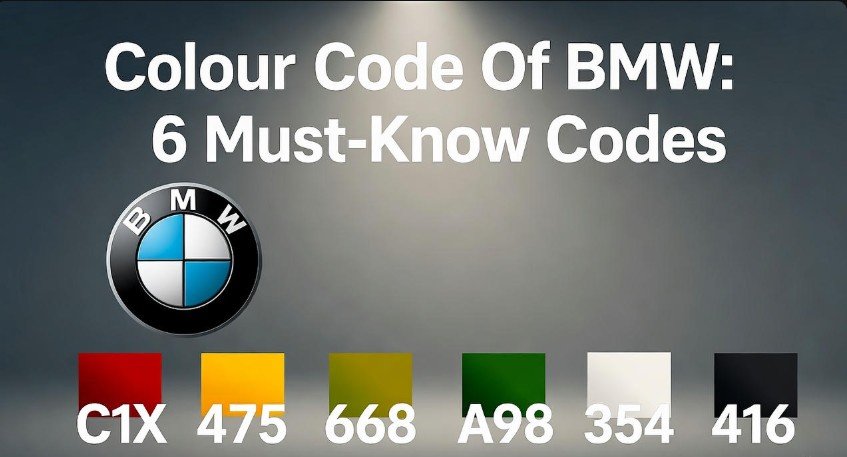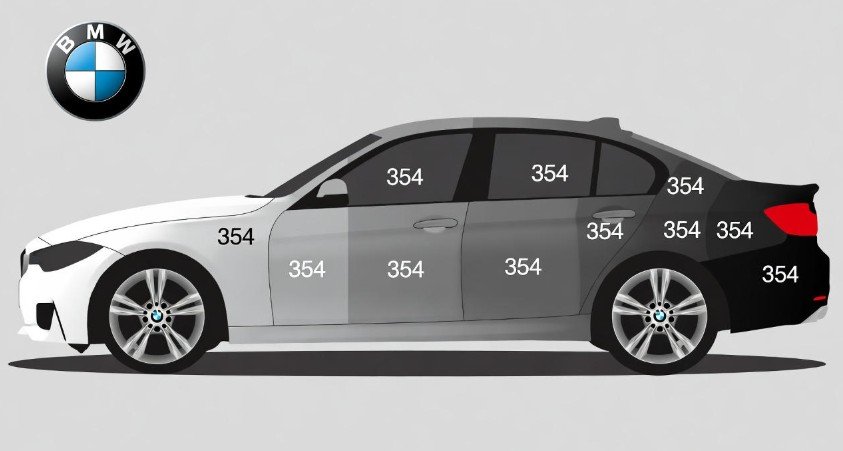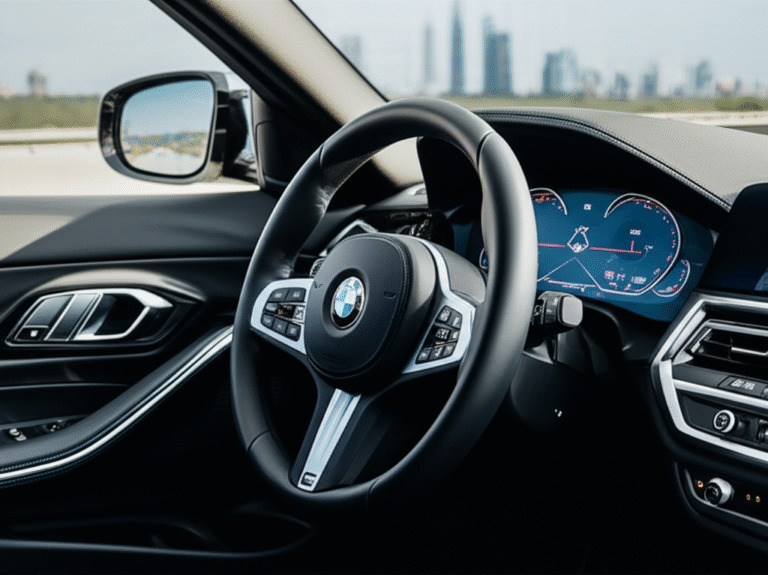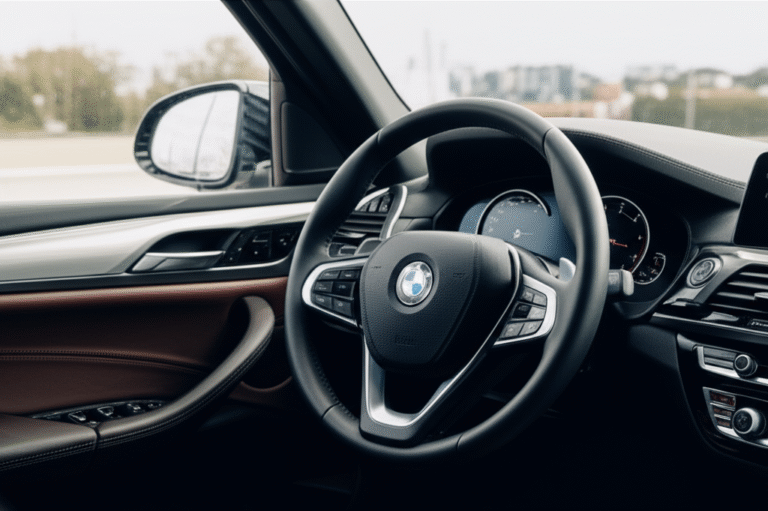Colour Code Of BMW: 6 Must-Know Codes

Discover the secret BMW color codes to identify your car’s exact paint shade, essential for repairs and customization.
Key Takeaways
- Decode BMW paint with 6 crucial color codes.
- Find your BMW’s color code easily.
- Understand official BMW color names.
- Learn how codes aid repairs and touch-ups.
- Explore common BMW color code types.
- Get code insights for customization projects.
Navigating the world of automotive paint can seem complicated, especially when it comes to a brand as diverse and customized as BMW. You’ve likely seen stunning BMWs in every shade imaginable, from deep blues to vibrant reds. But what happens when you need a touch-up paint pen, or you’re looking to understand the exact specification of your car’s hue? That’s where the BMW color code comes in. These seemingly small alphanumeric strings are the key to unlocking your vehicle’s precise paint finish. Without them, matching paint for repairs or even just identifying the official name of your BMW’s color can be a frustrating guessing game. This guide will demystify the BMW color code, focusing on six essential codes every owner needs to know, making maintenance and customization simpler than ever. Let’s dive into how you can easily find and understand these vital identifiers.
Understanding the BMW Color Code System

BMW, like most major automakers, uses a specific system to identify the exact paint color applied to their vehicles. This system is crucial for several reasons. When you need to repair a scratch or chip, having the correct color code ensures a perfect match, preventing a noticeable difference between the original paint and the repair. For enthusiasts looking to customize their BMW, knowing the original color code is the first step in a successful project, allowing for accurate selection of accessories or even a full respray that stays true to the car’s heritage. The BMW color code is typically found on a sticker or plate located in a specific area of your vehicle. It’s usually a combination of letters and numbers, and it’s paired with a descriptive color name.
The importance of these codes cannot be overstated. They are the universal language for automotive paint. A common misconception is that “Alpine White” is just one shade. However, BMW has produced numerous whites over the years, each with its own unique code and subtle differences. Without the code, you might end up with a white that doesn’t perfectly match your car, especially if the paint has faded or oxidized over time. This is why understanding and knowing how to find your BMW’s color code is a fundamental skill for any owner.
Where to Find Your BMW Color Code
Locating your BMW’s color code is usually straightforward, but knowing where to look is key. The most common place to find this information is on the VIN sticker, also known as the vehicle identification number sticker. This sticker is typically placed on the driver’s side door jamb or the door edge. When you open the driver’s side door, look along the frame where the door latches. You should see a sticker with various vehicle specifications and codes.
Another common location, especially on older BMW models, is under the hood, often on the strut tower or firewall. Some sources also suggest checking the passenger side door jamb. The sticker usually contains your car’s VIN, production date, weight information, and importantly, the paint color code. This code is often labeled as “S” or “Color Code” and is typically a three-digit alphanumeric sequence, sometimes followed by additional characters that denote specific variations or finishes. It’s crucial to differentiate this code from the interior trim code, which will be listed separately.
If you’re still having trouble finding the sticker, don’t worry. Your BMW’s owner’s manual might provide guidance on where to locate this information. Alternatively, you can always contact a BMW dealership or a reputable BMW specialist. They can access your vehicle’s specifications using your VIN and provide you with the exact color code. Remember, having the correct code is essential for any paint-related work.
Decoding the Color Code: What the Numbers Mean
BMW’s color codes, while specific, follow a general pattern that helps in understanding them. Most commonly, you’ll encounter a three-digit code. For example, a code like “300” often represents Alpine White III. The first digit usually indicates the general color family, while the subsequent digits and letters refine the specific shade, finish (like metallic, non-metallic, or pearl), and sometimes even the production era of that color. It’s important to note that BMW’s official color names are also linked to these codes, providing a descriptive identifier.
For instance, a code might look like “B45” for Estoril Blue. The “B” could signify a blue hue, and “45” would be the specific identifier for that particular shade. Metallic paints often have additional indicators or specific naming conventions. BMW’s extensive palette means there are hundreds of color codes, and understanding this basic structure helps you interpret what the code represents. Some codes might include suffixes or prefixes indicating special editions or specific paint technologies used by BMW.
It’s also worth mentioning that BMW uses a system where the same color can sometimes have slightly different codes across different model years or manufacturing plants due to minor variations in paint formulations. This reinforces the importance of using the code found on your specific vehicle’s sticker. Websites like RealOEM.com can be invaluable resources for looking up BMW parts and paint codes using your VIN, offering an in-depth look at BMW’s extensive catalog.
6 Must-Know BMW Color Codes and Their Significance
While BMW offers a vast spectrum of colors, certain shades have become iconic and are frequently seen on their vehicles. Understanding the codes for these popular colors is incredibly useful for owners, enthusiasts, and repair shops alike. Here are six must-know BMW color codes, along with their official names and what makes them significant.
1. 300 – Alpine White
Alpine White is arguably BMW’s most iconic and classic color. It’s a pure, bright white that has adorned countless BMW models for decades. It’s a non-metallic finish that conveys a sense of clean sportiness and timeless elegance. If your BMW is a brilliant white, chances are it’s Alpine White. This color is incredibly popular due to its broad appeal and how well it highlights BMW’s design lines. For any owner with a white BMW, recognizing code 300 is essential. It’s also one of the most common colors for aftermarket accessories or vinyl wraps.
2. 475 – Black Sapphire Metallic
Black Sapphire Metallic is a sophisticated and deep black finish with metallic flakes that give it a brilliant sparkle under direct light. This is a favorite for those who want a luxurious, imposing look. It’s a versatile color that looks equally stunning on sporty M models and elegant sedans. The metallic element makes it more dynamic than a standard solid black, offering depth and a premium feel. If your BMW is a dark, lustrous black that gleams, 475 is a strong candidate.
3. A68 – Millennium Silver Metallic
Millennium Silver Metallic is a popular choice for its understated elegance and ability to mask light dirt and minor imperfections better than darker colors. It’s a sophisticated silver with a subtle metallic finish that lends a premium look without being overly flashy. Silver is a timeless automotive color, and BMW’s iteration is particularly well-regarded for its depth and clarity. This code is vital for owners who appreciate a classic, clean aesthetic and require precise color matching for their silver BMW.
4. A96 – Mineral White Metallic
While Alpine White is a pure white, Mineral White Metallic offers a more complex, pearlescent white finish. It has a subtle depth and shimmer that makes the car appear to change hue slightly depending on the light. This is a modern and luxurious take on white, adding a premium, almost ethereal quality to the vehicle. It’s a very popular choice on higher-end BMW models and is a significant departure from the starkness of solid white. If your white BMW has a subtle pearlescent glow, A96 is likely your color.
5. 430 – Individual Ruby Black Metallic
This is an example of a BMW Individual color, which offers a level of customization beyond the standard palette. Ruby Black Metallic is a stunning, deep black with subtle red undertones that can reveal themselves in certain lighting conditions, giving it a unique, jewel-like appearance. These individual colors often come with higher price tags but offer unparalleled exclusivity. Knowing the code for such a distinctive color is crucial for anyone who owns or admires these special editions.
6. 445 – Midnight Blue Metallic
Midnight Blue Metallic is a deep, dark blue that often appears almost black in low light but reveals its rich blue hue under sunlight. It’s a sophisticated color that offers an alternative to black while retaining a sense of luxury and sportiness. This shade is particularly popular on BMW sedans and coupes, providing a distinguished and elegant look. If your BMW is a dark, moody blue, code 445 is a strong possibility.
BMW Paint Code Table: Common Colors and Codes
To further illustrate the variety and specificity of BMW paint codes, here is a table featuring some common and popular colors. This table provides a quick reference for identifying these shades and their corresponding codes. It’s important to remember that BMW has a vast catalog, and this is just a small selection.
| BMW Color Name | Color Code | Color Type | Commonly Found On |
|---|---|---|---|
| Alpine White III | 300 | Solid (Non-Metallic) | Most BMW Models |
| Black Sapphire Metallic | 475 | Metallic | Most BMW Models |
| Melbourne Red Metallic | A27 | Metallic | 3 Series, 4 Series, X Models |
| Estoril Blue II Metallic | B45 | Metallic | M2, M3, M4 |
| Mineral Grey Metallic | B39 | Metallic | Most BMW Models |
| Glacier Silver Metallic | A83 | Metallic | Most BMW Models |
| Sakhir Orange II Metallic | C10 | Metallic | M Models, Performance Line Models |
| Mineral White Metallic | A96 | Metallic/Pearlescent | Most BMW Models |
| Black II | 007 | Solid (Non-Metallic) | Older Models, specific variants |
| Signal Green | 227 | Solid (Non-Metallic) | Special Editions, Individual |
Why Correct Color Matching is Crucial
The primary reason for understanding BMW color codes is the absolute necessity for correct paint matching. When your car suffers minor damage, like a scratch from a rogue shopping cart or a chip from a flying stone on the highway, a touch-up paint job is often the first line of defense. If the color doesn’t match precisely, the repair will be obvious, potentially decreasing your car’s aesthetic appeal and resale value. This is especially true for modern cars with sophisticated paint finishes like metallics and pearls, which have complex compositions that are difficult to replicate without the exact code.
Beyond simple touch-ups, professional body shops rely heavily on these codes for larger repairs or full resprays. Using the wrong color code can lead to costly mistakes that require redoing the entire job. Furthermore, the environment your car has been in over the years can affect its paint. UV exposure, weather, and general wear can cause the original paint to fade or change hue. A good auto body technician will use your car’s original color code as a starting point and then make minor adjustments based on the current condition of your vehicle’s paint to achieve the best possible match. For more information on automotive paint and its complexities, resources like the U.S. Environmental Protection Agency (EPA) provide insights into regulations surrounding automotive coatings.
Using BMW Color Codes for Customization
For BMW enthusiasts, the color code is not just about maintenance; it’s a gateway to personalization. Whether you’re planning to repaint your entire car, add custom racing stripes, paint brake calipers, or even choose a new set of wheels that complement your car’s original color, knowing your BMW’s color code is essential. It allows you to:
- Purchase Color-Matched Accessories: Many aftermarket parts, like spoiler lips, mirror caps, or interior trim pieces, can be ordered pre-painted to match your BMW’s factory color. The color code ensures accuracy.
- Plan Vinyl Wraps: If you’re considering a vinyl wrap instead of a traditional paint job, knowing your original color code helps you select complementary or contrasting wrap colors. You might also use it to ensure a perfect match if you plan to wrap only certain sections of the car.
- Communicate with Custom Shops: When working with custom paint shops, providing the exact BMW color code ensures they understand your precise vision. This avoids misinterpretations and ensures the final result aligns with your expectations.
- Maintain Color Consistency: If you’re modifying specific parts of your car, like a spoiler or side skirts, using the original color code for these components will guarantee they match the rest of the vehicle perfectly.
The BMW Individual program, for instance, offers an almost limitless palette of colors, each with its unique code. These bespoke options allow owners to create truly one-of-a-kind vehicles. Even if you’re not opting for a full Individual color, understanding the nuances of metallic flakes, pearls, and solid finishes associated with your color code can help you make informed decisions about aesthetic modifications.
Pro Tip: Always Check Your VIN Decoder
While the sticker on your car is the primary source for your BMW color code, it’s always a good practice to cross-reference it using a VIN decoder. Online VIN decoders, often available through automotive forums or specialized websites like BMW-specific VIN decoders, can provide a wealth of information about your car’s original specifications, including the paint color code and name. This is a great way to verify the information on your sticker or if the sticker is damaged or missing.
Troubleshooting and Common Issues with BMW Color Codes
While the BMW color code system is generally reliable, there can be occasional challenges. One common issue is the existence of multiple versions of a popular color over different model years. For example, there might be “Alpine White” and “Alpine White II” or “Alpine White III,” each with a distinct code. It’s crucial to identify the code specifically for your car’s production year.
Another problem can arise if the paint code on your vehicle’s sticker is unclear or damaged. In such cases, relying on a VIN decoder or consulting a BMW dealership is the best course of action. Sometimes, a car might have been repainted before you purchased it, and the new paint might not match the original code. If you suspect this has happened, a professional body shop can perform a paint analysis to determine the current color and its composition.
It’s also important to distinguish between the exterior paint code and interior trim codes, which are often found on the same sticker. Make sure you are referencing the code designated for the exterior paint. Finally, even with the correct code, minor variations in paint application or aging can lead to slight differences. This is why professional painters often “blend” new paint into surrounding areas to ensure a seamless transition.
Frequently Asked Questions (FAQ)
How do I know if my BMW has a metallic paint finish?
Metallic paint finishes typically have a sparkle or shimmer due to the presence of metallic flakes in the paint layer. When you look closely at the paint, especially in sunlight, you’ll see tiny reflective particles. Solid or non-metallic paints appear uniform in color without this shimmering effect. The color code itself often doesn’t explicitly state “metallic” but will be associated with official BMW descriptions that include “Metallic” or “S.”
Can I use a generic touch-up paint if I don’t have the BMW color code?
It is highly recommended to always use the specific BMW color code for touch-up paint. Generic touch-up paints are unlikely to provide an exact match, leading to a noticeable discrepancy once applied. The precise formulation of BMW paints is designed to meet the brand’s aesthetic standards, and using the correct code ensures the best possible repair. If you cannot find your code, contact a BMW dealer or specialist.
What is the difference between a BMW color code and a BMW paint name?
The BMW color code (e.g., 300, 475) is an alphanumeric identifier that precisely specifies the paint mixture. The BMW paint name (e.g., Alpine White, Black Sapphire Metallic) is the descriptive, common name for that particular shade. The code is the technical key, while the name is the everyday label. Both are important, but the code is essential for ordering exact paint matches.
Are BMW Individual colors more expensive to maintain?
Generally, BMW Individual colors are purchased with a higher initial cost due to their custom nature. However, their maintenance requirements are typically the same as standard BMW paints. The key to maintaining them is using the correct color code for any touch-ups or repairs and following standard car care practices like regular washing and waxing. Specialized cleaning products might be recommended for certain finishes, but this is usually indicated by BMW or the paint manufacturer.
My BMW’s paint looks faded. Will the color code help?
Yes, the color code is your starting point. Even if the paint has faded, knowing the original code allows a professional painter to order the correct base color. They can then adjust the formula based on the current condition of your car’s paint, compensating for the fading or oxidizing to achieve the closest possible match. It’s a crucial step for any paint restoration work.
Where can I find a list of all BMW color codes?
BMW maintains an extensive internal database of all color codes used throughout its history. While BMW dealerships and official BMW parts websites are the most reliable sources for specific codes, many enthusiast websites and automotive forums compile lists of common BMW color codes. Websites like RealOEM.com can also be very helpful for looking up part numbers and associated paint codes for specific BMW models when you have your VIN.
Conclusion
Understanding your BMW’s color code is more than just a technical detail; it’s a fundamental aspect of maintaining your vehicle’s pristine appearance and ensuring accurate repairs. From the iconic Alpine White (300) to the sophisticated Black Sapphire Metallic (475), each code represents a specific hue that contributes to the distinct character of a BMW. By knowing where to find this vital information on your vehicle and what it signifies, you empower yourself to make informed decisions, whether you’re performing a simple DIY touch-up, commissioning a professional paint job, or embarking on a custom modification project. Remember to always use your vehicle’s specific identifier, and for any complex issues, consult with BMW specialists or reputable auto body shops. Driving a BMW is a statement, and preserving its flawless finish ensures that statement is always clear and impactful.






